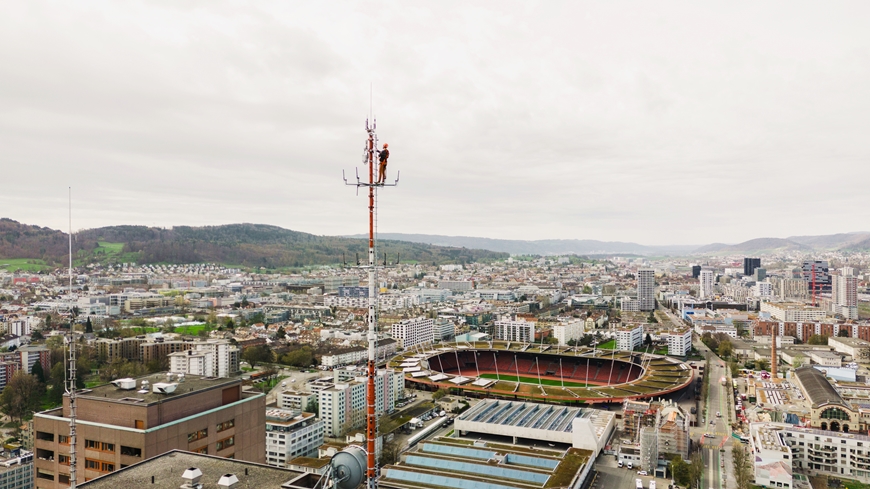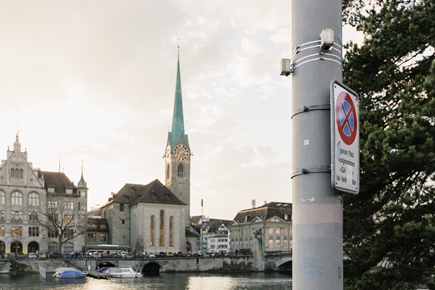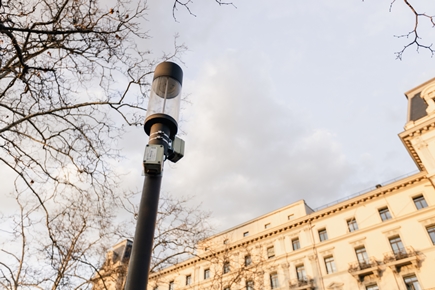ICOS Cities
How much CO₂ does Zurich emit?
To achieve net zero, we need to reduce our CO₂ emissions quickly and efficiently. An EU project involving Empa has selected Zurich as one of three pilot cities in Europe to accurately measure and model their carbon dioxide emissions. The findings will help cities to achieve their climate targets.

Cities are the largest source of greenhouse gases in the world. Around 70% of all anthropogenic emissions are produced in, around and by cities. At the same time, they have great scope for action to reduce these emissions. Many urban areas have more ambitious climate targets than their countries – including the city of Zurich, which aims to achieve net zero by 2040, ten years before Switzerland. Reducing greenhouse gas emissions in such a short space of time requires reliable data. They show progress, reflect the effectiveness of measures and create incentives by making emissions more visible and tangible. "No diet can be successful without a scale," summarizes Lukas Emmenegger, Head of Empa's Laboratory for Air Pollutants / Environmental Technology.
But how can we measure the emissions of an entire city? This question is being addressed by the EU project ICOS Cities, in which Zurich is one of three pilot cities, together with Paris and Munich. As part of ICOS Cities, scientists want to work with city administrations to develop methods for measuring and modeling emissions in cities. It is no coincidence that Zurich is one of the three "chosen" cities. "The city already has high-quality data on its emissions, has a 'digital twin' and is very open with these resources," explains Emmenegger. Empa has also contributed to this: "When ICOS Cities was launched, we already had a CO2 measurement network throughout Switzerland, including in Zurich," says Empa researcher Dominik Brunner.
Measuring emissions...

As part of ICOS Cities, Empa researchers have expanded this network to 60 locations throughout the city. The inexpensive, small measuring devices cling inconspicuously to street lamps and trees from Uetliberg to Irchel. This low-cost sensor network is supplemented by a mid-cost network. In collaboration with Swisscom, Empa researchers were able to install around 20 more complex instruments on mobile phone antennas in the city. A measuring tower on the roof of a high-rise building in Hardau rounds off the measurement palette. There, high-precision measurements were carried out at certain times under the direction of the University of Basel in order to record other greenhouse gases such as methane and nitrous oxide and to understand the complex CO₂ fluxes above the city.
This complexity is needed because selective measurements of CO₂ concentrations do not reveal much about emissions. The complex topography of the city, especially that of Zurich, creates air currents that are difficult to predict and can quickly transport the greenhouse gas away from its source. "Another challenge is to distinguish anthropogenic emissions from the natural CO₂ cycle in the atmosphere," says Brunner. The large forests around the city breathe in and breathe out large quantities of carbon dioxide every day. The University of Basel also measures and studies these natural fluctuations caused by plants.
... and understanding them

The Empa researchers incorporate this and all other data from the project – and there is a lot of it – Into their models. Modeling is the final and most important step in understanding the city's emissions. Where does the measured CO₂ originate? What influence does the weather have on the concentrations? Which part is natural and which is anthropogenic?
The team led by modeling expert Brunner is looking for answers to these questions together with partners abroad. To this end, they are developing two models: One shows how the city releases carbon dioxide to an accuracy of around one kilometer. The second model "sees" individual buildings. "We compare these models with the city's emissions estimates, known as the CO₂ inventory," explains Brunner. The work, especially on the complex high-resolution model, is not quite done yet. But the results are promising. For example, the researchers were able to measure and model a noticeable reduction for the winter of 2022/23: The city had significantly reduced its energy consumption at that time due to the energy crisis. The models work.
A recipe for sustainability
This modeling expertise is another reason why Zurich, of all places, was chosen as the pilot city. "Empa is one of the few institutes in the world that combines both measurements and modeling under one roof," says Emmenegger. As a founding partner of the National Air Pollution Monitoring Network (NABEL), which has been in operation since 1979, Empa can look back on a long "career" in the determination of (trace) gases in the air.
While in the 1970s the focus was exclusively on pollutants, today, researchers are also looking at carbon dioxide and other greenhouse gases. By developing and comparing different measurement methods and models in ICOS Cities, they want to develop a kind of cookbook for Zurich and other cities, with different recipes for monitoring their CO₂ emissions. The project will run until 2025, after which it will be the cities' turn: what they "cook" with the recipes from the project is up to them. "The city of Zurich is an important and committed partner in the project," says Emmenegger. "We hope our findings will help them achieve their climate targets."
ICOS
The Integrated Carbon Observation System (ICOS) is a European research infrastructure that investigates the global carbon cycle and how it is influenced by human activities. ICOS currently collects standardized, freely accessible data from more than 180 measuring stations in 16 countries.
Switzerland participates with stations on the Jungfraujoch and in Davos. With the ICOS Cities project, ICOS aims to lay the foundations for expanding its three existing focal points – atmosphere, oceans and ecosystems – to include cities as important CO₂ emitters.
ICOS Switzerland consists of the institutions ETH Zurich, Empa and WSL, the Universities of Bern and Basel and MeteoSwiss.
Dr. Lukas Emmenegger
Air-Pollution-Environmental-Technology
Phone +41 58 765 4699
Anna Ettlin
Communications
Phone +41 58 765 4733
redaktion@empa.ch
ICOS
Communications team
Open Lab Day
On September 14, 2024, Empa Dübendorf will open the doors of its laboratories to the public. At over 70 stations, visitors will be able to experience current Empa research live on topics such as climate change, the energy transition, human and environmental health and much more. The stories in this issue give a small taste of the variety of materials and technologies that are discovered, researched, and developed in Empa's laboratories. Hungry for more? Visit us on September 14!
Read the latest EmpaQuarterly online or download the PDF version.
-
Share







